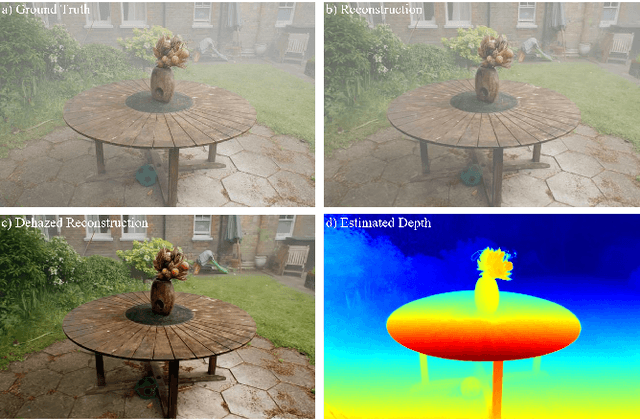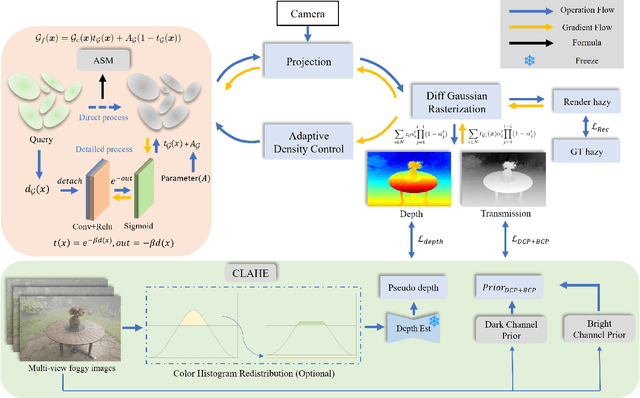Xiaopeng Zhang
Temporal Action Selection for Action Chunking
Nov 06, 2025Abstract:Action chunking is a widely adopted approach in Learning from Demonstration (LfD). By modeling multi-step action chunks rather than single-step actions, action chunking significantly enhances modeling capabilities for human expert policies. However, the reduced decision frequency restricts the utilization of recent observations, degrading reactivity - particularly evident in the inadequate adaptation to sensor noise and dynamic environmental changes. Existing efforts to address this issue have primarily resorted to trading off reactivity against decision consistency, without achieving both. To address this limitation, we propose a novel algorithm, Temporal Action Selector (TAS), which caches predicted action chunks from multiple timesteps and dynamically selects the optimal action through a lightweight selector network. TAS achieves balanced optimization across three critical dimensions: reactivity, decision consistency, and motion coherence. Experiments across multiple tasks with diverse base policies show that TAS significantly improves success rates - yielding an absolute gain of up to 73.3%. Furthermore, integrating TAS as a base policy with residual reinforcement learning (RL) substantially enhances training efficiency and elevates the performance plateau. Experiments in both simulation and physical robots confirm the method's efficacy.
MASH: Cooperative-Heterogeneous Multi-Agent Reinforcement Learning for Single Humanoid Robot Locomotion
Aug 14, 2025Abstract:This paper proposes a novel method to enhance locomotion for a single humanoid robot through cooperative-heterogeneous multi-agent deep reinforcement learning (MARL). While most existing methods typically employ single-agent reinforcement learning algorithms for a single humanoid robot or MARL algorithms for multi-robot system tasks, we propose a distinct paradigm: applying cooperative-heterogeneous MARL to optimize locomotion for a single humanoid robot. The proposed method, multi-agent reinforcement learning for single humanoid locomotion (MASH), treats each limb (legs and arms) as an independent agent that explores the robot's action space while sharing a global critic for cooperative learning. Experiments demonstrate that MASH accelerates training convergence and improves whole-body cooperation ability, outperforming conventional single-agent reinforcement learning methods. This work advances the integration of MARL into single-humanoid-robot control, offering new insights into efficient locomotion strategies.
METEOR: Multi-Encoder Collaborative Token Pruning for Efficient Vision Language Models
Jul 28, 2025Abstract:Vision encoders serve as the cornerstone of multimodal understanding. Single-encoder architectures like CLIP exhibit inherent constraints in generalizing across diverse multimodal tasks, while recent multi-encoder fusion methods introduce prohibitive computational overhead to achieve superior performance using complementary visual representations from multiple vision encoders. To address this, we propose a progressive pruning framework, namely Multi-Encoder collaboraTivE tOken pRuning (METEOR), that eliminates redundant visual tokens across the encoding, fusion, and decoding stages for multi-encoder MLLMs. For multi-vision encoding, we discard redundant tokens within each encoder via a rank guided collaborative token assignment strategy. Subsequently, for multi-vision fusion, we combine the visual features from different encoders while reducing cross-encoder redundancy with cooperative pruning. Finally, we propose an adaptive token pruning method in the LLM decoding stage to further discard irrelevant tokens based on the text prompts with dynamically adjusting pruning ratios for specific task demands. To our best knowledge, this is the first successful attempt that achieves an efficient multi-encoder based vision language model with multi-stage pruning strategies. Extensive experiments on 11 benchmarks demonstrate the effectiveness of our proposed approach. Compared with EAGLE, a typical multi-encoder MLLMs, METEOR reduces 76% visual tokens with only 0.3% performance drop in average. The code is available at https://github.com/YuchenLiu98/METEOR.
Edge-ASR: Towards Low-Bit Quantization of Automatic Speech Recognition Models
Jul 10, 2025Abstract:Recent advances in Automatic Speech Recognition (ASR) have demonstrated remarkable accuracy and robustness in diverse audio applications, such as live transcription and voice command processing. However, deploying these models on resource constrained edge devices (e.g., IoT device, wearables) still presents substantial challenges due to strict limits on memory, compute and power. Quantization, particularly Post-Training Quantization (PTQ), offers an effective way to reduce model size and inference cost without retraining. Despite its importance, the performance implications of various advanced quantization methods and bit-width configurations on ASR models remain unclear. In this work, we present a comprehensive benchmark of eight state-of-the-art (SOTA) PTQ methods applied to two leading edge-ASR model families, Whisper and Moonshine. We systematically evaluate model performances (i.e., accuracy, memory I/O and bit operations) across seven diverse datasets from the open ASR leaderboard, analyzing the impact of quantization and various configurations on both weights and activations. Built on an extension of the LLM compression toolkit, our framework integrates edge-ASR models, diverse advanced quantization algorithms, a unified calibration and evaluation data pipeline, and detailed analysis tools. Our results characterize the trade-offs between efficiency and accuracy, demonstrating that even 3-bit quantization can succeed on high capacity models when using advanced PTQ techniques. These findings provide valuable insights for optimizing ASR models on low-power, always-on edge devices.
OmniDraft: A Cross-vocabulary, Online Adaptive Drafter for On-device Speculative Decoding
Jul 03, 2025Abstract:Speculative decoding generally dictates having a small, efficient draft model that is either pretrained or distilled offline to a particular target model series, for instance, Llama or Qwen models. However, within online deployment settings, there are two major challenges: 1) usage of a target model that is incompatible with the draft model; 2) expectation of latency improvements over usage and time. In this work, we propose OmniDraft, a unified framework that enables a single draft model to operate with any target model and adapt dynamically to user data. We introduce an online n-gram cache with hybrid distillation fine-tuning to address the cross-vocabulary mismatch across draft and target models; and further improve decoding speed by leveraging adaptive drafting techniques. OmniDraft is particularly suitable for on-device LLM applications where model cost, efficiency and user customization are the major points of contention. This further highlights the need to tackle the above challenges and motivates the \textit{``one drafter for all''} paradigm. We showcase the proficiency of the OmniDraft framework by performing online learning on math reasoning, coding and text generation tasks. Notably, OmniDraft enables a single Llama-68M model to pair with various target models including Vicuna-7B, Qwen2-7B and Llama3-8B models for speculative decoding; and additionally provides up to 1.5-2x speedup.
Tackling View-Dependent Semantics in 3D Language Gaussian Splatting
May 30, 2025Abstract:Recent advancements in 3D Gaussian Splatting (3D-GS) enable high-quality 3D scene reconstruction from RGB images. Many studies extend this paradigm for language-driven open-vocabulary scene understanding. However, most of them simply project 2D semantic features onto 3D Gaussians and overlook a fundamental gap between 2D and 3D understanding: a 3D object may exhibit various semantics from different viewpoints--a phenomenon we term view-dependent semantics. To address this challenge, we propose LaGa (Language Gaussians), which establishes cross-view semantic connections by decomposing the 3D scene into objects. Then, it constructs view-aggregated semantic representations by clustering semantic descriptors and reweighting them based on multi-view semantics. Extensive experiments demonstrate that LaGa effectively captures key information from view-dependent semantics, enabling a more comprehensive understanding of 3D scenes. Notably, under the same settings, LaGa achieves a significant improvement of +18.7% mIoU over the previous SOTA on the LERF-OVS dataset. Our code is available at: https://github.com/SJTU-DeepVisionLab/LaGa.
Multimodal Fusion and Vision-Language Models: A Survey for Robot Vision
Apr 03, 2025Abstract:Robot vision has greatly benefited from advancements in multimodal fusion techniques and vision-language models (VLMs). We systematically review the applications of multimodal fusion in key robotic vision tasks, including semantic scene understanding, simultaneous localization and mapping (SLAM), 3D object detection, navigation and localization, and robot manipulation. We compare VLMs based on large language models (LLMs) with traditional multimodal fusion methods, analyzing their advantages, limitations, and synergies. Additionally, we conduct an in-depth analysis of commonly used datasets, evaluating their applicability and challenges in real-world robotic scenarios. Furthermore, we identify critical research challenges such as cross-modal alignment, efficient fusion strategies, real-time deployment, and domain adaptation, and propose future research directions, including self-supervised learning for robust multimodal representations, transformer-based fusion architectures, and scalable multimodal frameworks. Through a comprehensive review, comparative analysis, and forward-looking discussion, we provide a valuable reference for advancing multimodal perception and interaction in robotic vision. A comprehensive list of studies in this survey is available at https://github.com/Xiaofeng-Han-Res/MF-RV.
RASA: Replace Anyone, Say Anything -- A Training-Free Framework for Audio-Driven and Universal Portrait Video Editing
Mar 14, 2025Abstract:Portrait video editing focuses on modifying specific attributes of portrait videos, guided by audio or video streams. Previous methods typically either concentrate on lip-region reenactment or require training specialized models to extract keypoints for motion transfer to a new identity. In this paper, we introduce a training-free universal portrait video editing framework that provides a versatile and adaptable editing strategy. This framework supports portrait appearance editing conditioned on the changed first reference frame, as well as lip editing conditioned on varied speech, or a combination of both. It is based on a Unified Animation Control (UAC) mechanism with source inversion latents to edit the entire portrait, including visual-driven shape control, audio-driven speaking control, and inter-frame temporal control. Furthermore, our method can be adapted to different scenarios by adjusting the initial reference frame, enabling detailed editing of portrait videos with specific head rotations and facial expressions. This comprehensive approach ensures a holistic and flexible solution for portrait video editing. The experimental results show that our model can achieve more accurate and synchronized lip movements for the lip editing task, as well as more flexible motion transfer for the appearance editing task. Demo is available at https://alice01010101.github.io/RASA/.
DehazeGS: Seeing Through Fog with 3D Gaussian Splatting
Jan 07, 2025



Abstract:Current novel view synthesis tasks primarily rely on high-quality and clear images. However, in foggy scenes, scattering and attenuation can significantly degrade the reconstruction and rendering quality. Although NeRF-based dehazing reconstruction algorithms have been developed, their use of deep fully connected neural networks and per-ray sampling strategies leads to high computational costs. Moreover, NeRF's implicit representation struggles to recover fine details from hazy scenes. In contrast, recent advancements in 3D Gaussian Splatting achieve high-quality 3D scene reconstruction by explicitly modeling point clouds into 3D Gaussians. In this paper, we propose leveraging the explicit Gaussian representation to explain the foggy image formation process through a physically accurate forward rendering process. We introduce DehazeGS, a method capable of decomposing and rendering a fog-free background from participating media using only muti-view foggy images as input. We model the transmission within each Gaussian distribution to simulate the formation of fog. During this process, we jointly learn the atmospheric light and scattering coefficient while optimizing the Gaussian representation of the hazy scene. In the inference stage, we eliminate the effects of scattering and attenuation on the Gaussians and directly project them onto a 2D plane to obtain a clear view. Experiments on both synthetic and real-world foggy datasets demonstrate that DehazeGS achieves state-of-the-art performance in terms of both rendering quality and computational efficiency.
LiftImage3D: Lifting Any Single Image to 3D Gaussians with Video Generation Priors
Dec 12, 2024Abstract:Single-image 3D reconstruction remains a fundamental challenge in computer vision due to inherent geometric ambiguities and limited viewpoint information. Recent advances in Latent Video Diffusion Models (LVDMs) offer promising 3D priors learned from large-scale video data. However, leveraging these priors effectively faces three key challenges: (1) degradation in quality across large camera motions, (2) difficulties in achieving precise camera control, and (3) geometric distortions inherent to the diffusion process that damage 3D consistency. We address these challenges by proposing LiftImage3D, a framework that effectively releases LVDMs' generative priors while ensuring 3D consistency. Specifically, we design an articulated trajectory strategy to generate video frames, which decomposes video sequences with large camera motions into ones with controllable small motions. Then we use robust neural matching models, i.e. MASt3R, to calibrate the camera poses of generated frames and produce corresponding point clouds. Finally, we propose a distortion-aware 3D Gaussian splatting representation, which can learn independent distortions between frames and output undistorted canonical Gaussians. Extensive experiments demonstrate that LiftImage3D achieves state-of-the-art performance on two challenging datasets, i.e. LLFF, DL3DV, and Tanks and Temples, and generalizes well to diverse in-the-wild images, from cartoon illustrations to complex real-world scenes.
 Add to Chrome
Add to Chrome Add to Firefox
Add to Firefox Add to Edge
Add to Edge